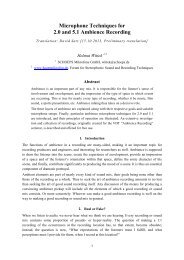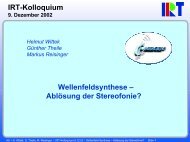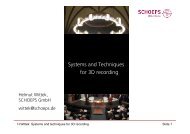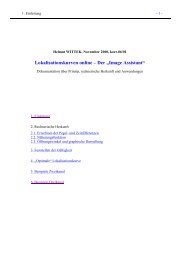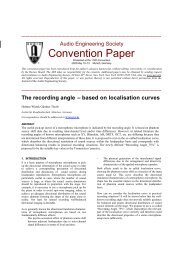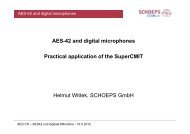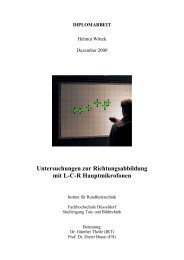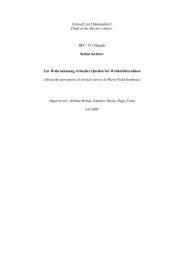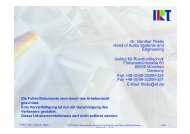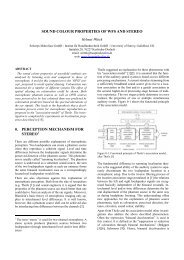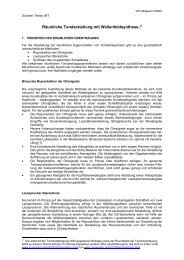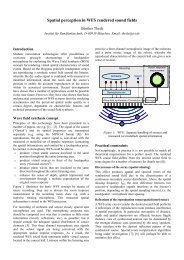on the localisation in the superimposed soundfield - Hauptmikrofon ...
on the localisation in the superimposed soundfield - Hauptmikrofon ...
on the localisation in the superimposed soundfield - Hauptmikrofon ...
Create successful ePaper yourself
Turn your PDF publications into a flip-book with our unique Google optimized e-Paper software.
22<br />
phenomena of spatial hear<strong>in</strong>g, hence offer<strong>in</strong>g new possibilities for <strong>the</strong>ir explanati<strong>on</strong>.<br />
Initially, this approach appears functi<strong>on</strong>al for two reas<strong>on</strong>s:<br />
1. It can offer an explanati<strong>on</strong> for <strong>the</strong> <strong>in</strong>effectiveness of <strong>the</strong> comb filter effect <strong>in</strong><br />
<strong>the</strong> phantom source situati<strong>on</strong> (see Secti<strong>on</strong> 3.2.2).<br />
2. It agrees with <strong>the</strong> hypo<strong>the</strong>sis that localisati<strong>on</strong> should be seen as <strong>the</strong> c<strong>on</strong>sequence<br />
of a perceptual process, which arises due to auditory experience<br />
al<strong>on</strong>e (see Secti<strong>on</strong>s 3.1.2 and 3.2.1).<br />
Therefore, <strong>the</strong> new localisati<strong>on</strong> model c<strong>on</strong>ta<strong>in</strong>s a process<strong>in</strong>g stage that, as a result of<br />
auditory experience, can separate such ear signal comp<strong>on</strong>ents. These comp<strong>on</strong>ents are<br />
coupled to each o<strong>the</strong>r due to <strong>the</strong> effect of <strong>the</strong> head and p<strong>in</strong>nae <strong>in</strong> <strong>the</strong> <strong>superimposed</strong><br />
sound field. In <strong>the</strong> follow<strong>in</strong>g, <strong>the</strong>se ear signal comp<strong>on</strong>ents shall be described as<br />
“localisati<strong>on</strong> stimuli”.<br />
Def<strong>in</strong>iti<strong>on</strong>:<br />
Sufficiently broadband ear signals or ear signal comp<strong>on</strong>ents at <strong>the</strong> ear drums of<br />
<strong>the</strong> two ears toge<strong>the</strong>r c<strong>on</strong>stitute a localisati<strong>on</strong> stimulus if, based <strong>on</strong> <strong>the</strong>ir temporal<br />
and spectral properties, <strong>the</strong>y can be mapped to a s<strong>in</strong>gle sound event locati<strong>on</strong>.<br />
The process<strong>in</strong>g stage for <strong>the</strong> selecti<strong>on</strong> of localisati<strong>on</strong> stimuli is called “locati<strong>on</strong><br />
associati<strong>on</strong> stage”. It precedes a sec<strong>on</strong>d, higher-level central process<strong>in</strong>g stage<br />
c<strong>on</strong>ta<strong>in</strong>ed <strong>in</strong> <strong>the</strong> model. This so-called “gestalt associati<strong>on</strong> stage” comprises those<br />
processes that determ<strong>in</strong>e <strong>the</strong> qualitative properties of an auditory event except for its<br />
spatial characteristics (see Secti<strong>on</strong> 3.2 for details).<br />
Hence, <strong>the</strong> localisati<strong>on</strong> model is essentially characterised by two-dimensi<strong>on</strong>al<br />
stimulus process<strong>in</strong>g. The rigorous differentiati<strong>on</strong> of <strong>the</strong> two process<strong>in</strong>g stages<br />
corresp<strong>on</strong>ds entirely to <strong>the</strong> two elementary areas of auditory experience: <strong>the</strong> received<br />
ear signals can be attributed to <strong>the</strong> two sound source characteristics of “locati<strong>on</strong>” and<br />
“signal”, which always occur <strong>in</strong> a pairwise fashi<strong>on</strong>. As a result, <strong>the</strong> auditory events<br />
occurr<strong>in</strong>g <strong>in</strong> <strong>the</strong> model can be traced back to <strong>the</strong> effects of a locati<strong>on</strong>- and gestaltdeterm<strong>in</strong><strong>in</strong>g<br />
process<strong>in</strong>g stage.<br />
A stimulus has to pass both of <strong>the</strong>se stages for it to lead to a percepti<strong>on</strong>. The two<br />
processes thus always determ<strong>in</strong>e <strong>the</strong> properties of auditory events <strong>in</strong> a c<strong>on</strong>jo<strong>in</strong>t<br />
fashi<strong>on</strong>. C<strong>on</strong>sequently, <strong>the</strong> gestalt-determ<strong>in</strong><strong>in</strong>g process<strong>in</strong>g stage is an element of <strong>the</strong><br />
localisati<strong>on</strong> model as well.



